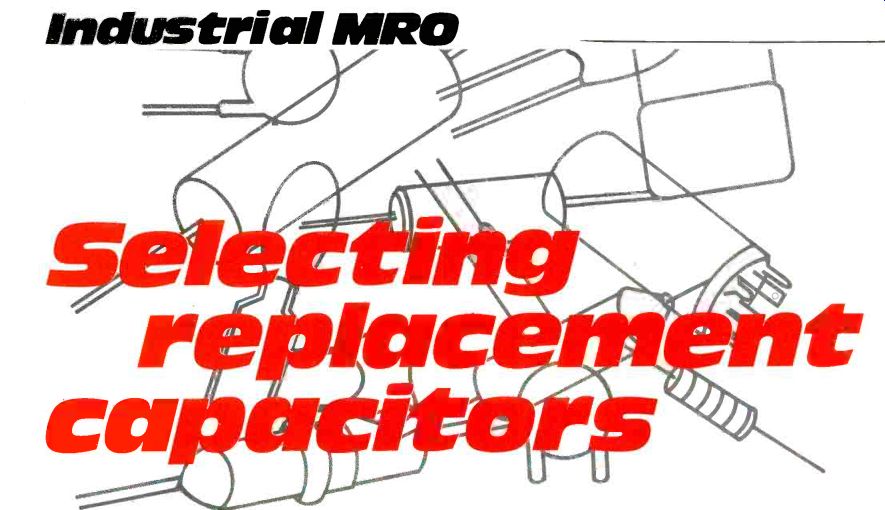
Capacitors are now available in a wide variety of types and specifications. These facts and suggestions should help technicians make the best selections of replacement capacitors.
By Carl Babcoke, CET
Installation of a new capacitor can degrade the performance of a critical circuit, if the replacement is selected solely for its capacitance value. For example, a high-K ceramic capacitor often produces creeping of the vertical-sweep frequency when it is substituted for a wound plastic/foil type in the vertical circuit.
Also, plastic/foil capacitors of ordinary characteristics will overheat and fail rapidly when connected across the damper diode in a transistorized horizontal-output stage or in certain points of an SCR-sweep circuit.
Careful selection of capacitors for critical circuits is one reason for the stable and reliable operation of modern solid-state color-TV receivers.
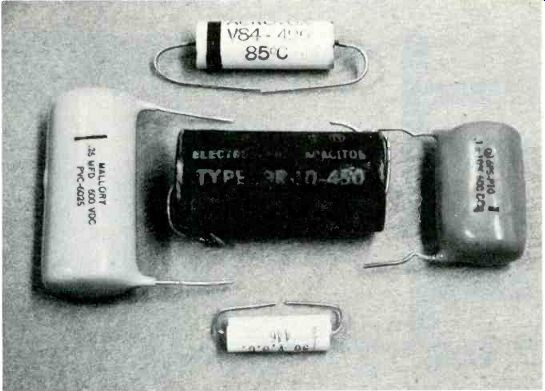
----------------- An aluminum-oxide electrolytic filter capacitor is shown
in the center of several types of wound film-foil capacitors.
Important characteristics
Several characteristics are important when a technician evaluates the suitability of a replacement capacitor.
Capacitance Value--All replacement capacitors are rated by a nominal capacitance value plus a tolerance rating. Filter, bypass and most coupling capacitors require only a certain minimum value.
Often the measured value can be 200% to 300% without affecting the performance. Capacitors that deter mine frequency should be stable and have the designated value.
Capacitors used in audio-frequency tone controls and equalizers should measure no more than 10% above or below the marked values.
Microfarad and picofarad are the two capacitance units most often used in servicing. A less familiar term is nanofarad, which is midway between microfarad and picofarad.
Tolerance--Permissible deviation from the nominal or marked capacitance is called tolerance, which usually is expressed in percentage, such as ±.10%.
Present availability of accurate digital-readout capacitance meters allows an electronic shop to buy quantities of broad-tolerance stable capacitors and then cull them for the few critical-value capacitors that are needed. This saves money by reducing inventory and using lower-cost components.
Insulation resistance--Dielectric strength (or insulation resistance) is the ohmmeter reading after a capacitor stops charging during a test.
Present-day capacitors (with the exception of large-value filters) seldom offer problems from insulation leakage. Any good brand of plastic-film or ceramic capacitors should be suitable for all replacements, except perhaps for a few blocking or coupling applications.
ESR-(Equivalent-Series Resistance) is the sum of all capacitor losses that act as if a resistance of that value is connected in series with a theoretically perfect capacitor. These losses include dielectric leakage, resistance of leads and plates, corona, and dielectric absorption. The obsolete term power , factor includes ESR and the dissipation factor.
All capacitors have ESR, but it is an undesirable condition. There fore, a low-value ESR resistance is preferable.
"Q" and dissipation factor--Capacitor "Q" is the ratio of capacitative reactance to the ESR. Dissipation factor (DF) is the mathematical reciprocal of "Q." It is prefer able for the "Q" to be high and the dissipation to below.
Di-electrical absorption--After a capacitor is charged, discharged thoroughly, and then allowed to rest, a certain percentage of the charging voltage will appear slowly across the leads. This is called di-electrical absorption, and it is not desirable. Perhaps the most spectacular examples are the strong shocks possible from picture-tube anode buttons after the glass-dielectric capacitance has been shorted to remove the charge.
Dielectric constant-Permittivity (sometimes erroneously called di-electric constant) describes the additional charge a capacitor can store when dielectrics other than a vacuum are used. This is not important in selecting replacements except that dielectric material of high permittivity allows a capacitor to be smaller physically for the same capacitance. The size/value relationship sometimes is called volumetric efficiency.
Working voltage--Ratings of working voltage are different for dc and ac applications. The voltages marked on capacitor bodies refer to the highest dc voltage permitted for constant operation. This working voltage must be derated severely for abnormal temperature, humidity and acV or transients. Although the factories test new capacitors for a short time at twice the rated dc voltage, in practical service it is advisable to select a dcV rating 50% above the actual voltage. For example, a plastic-dielectric capacitor operated at 400Vdc should be rated at 600Vdc. Except for size problems, there is no penalty for using capacitors of larger working voltages.

---------- Comparison of Foil Film Capacitors
CAP = capacitance
DF = dissipation factor
DA = dielectrical absorption
WA = water absorption
This is a comparison chart for five plastic-film capacitors, along with recommended applications.
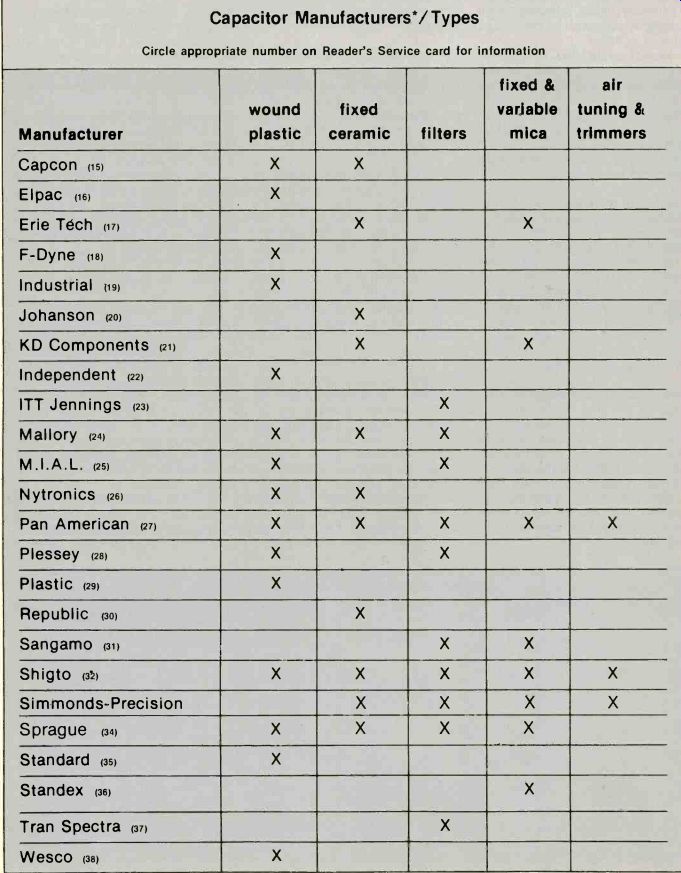
--------- Capacitor--Manufacturers—Types—
*This compilation represents only those manufacturers returning material to ES by press time.
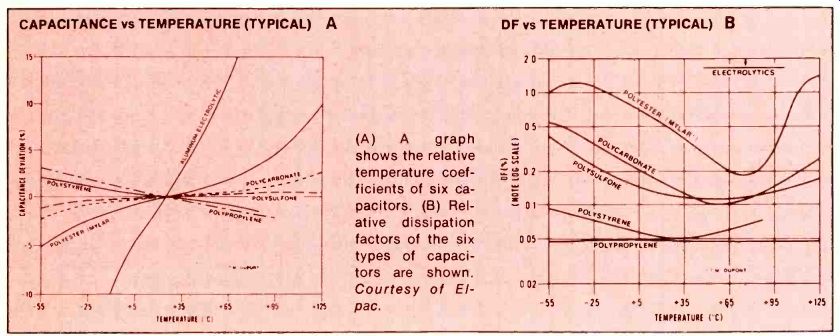
----------------- CAPACITANCE vs TEMPERATURE (TYPICAL) A DF vs TEMPERATURE
(TYPICAL) B (A) A graph shows the relative temperature coefficients of six
capacitors. (B) Relative dissipation factors of the six types of capacitors
are shown.
For acV ratings, a convenient rule is to select a capacitor having a dcV rating of three times the RMS acV. A capacitor for 120V RMS should be rated at 360Vdc or higher. However, an additional safety factor must be added to capacitors connected across the power line or in power supplies.
These components are subjected to transients and they should be rated much higher to provide an extra margin of safety.
Corona is another problem during ac operation. Corona has been defined as any electrically produced ionization. Horizontal-sweep pulses are the signal most likely to cause corona in TV receivers.
Dissipation factor is very important in the ac operation of capacitors. Losses from equivalent-series resistance occur only during charging or discharging of a capacitor.
With ac, these losses occur twice for each cycle, and each results in the production of heat. Excessive heat can cause early failure of capacitors.
All capacitors have a small inductive component. Therefore, they are limited in useable frequency response. Minimum impedance of some wound-film capacitors occurs around 10MHz. Polyester-dielectric capacitors generally have a more restricted high-frequency limit than other plastic-dielectric capacitors have.
In summary, care must be used regarding the corona and ESR ratings of capacitors used in horizontal-sweep circuits. This is especially important for the capacitors used in older SCR-sweep circuits, where certain capacitors are forced to handle 15,734Hz currents of several amperes. Conventional general-replacement types might run hot before shorting. Another critical application is the use of four-lead safety capacitors in the horizontal-output stage of solid-state color TVs. For example, Sprague lists PP16-S11S as replacement for Admiral 635102-2 and Zenith 22 7504-01. This is a four-lead poly propylene-dielectric safety capacitor that is identical to the original components.
Temperature coefficient--Changes of capacitance that occur from variations of temperature are described by temperature coefficient ratings. However, only special temperature-compensating ceramic types have a linear change with temperature.
They usually are rated in parts-per-million (PPM) for each Centigrade degree of change. Other capacitors having nonlinear variations are rated in percentage over the specified range. Other facts about temperature-caused capacitance variations are given with the various di electrics.

---- Six types of ceramic capacitors are grouped around a dipped-mica.
Mica capacitors continue to be specified where stability and dependability
are factors. Ceramic capacitors offer many different specifications.
Capacitor comparisons
Polyester, polycarbonate, polystyrene, polypropylene and polysulfone are the five most popular dielectric films. Polyester (Dupont Mylar) is commonly used when price is important than performance. It is a good compromise. However, the other four outperform polyester.
Metallized dielectrics--Capacitors of smaller physical sizes can be manufactured from plastic film that has had a metallic layer deposited on it by an evaporative process. The layer is thinner than the metal foil it replaces.
Another advantage is self-healing of some, shorts. The thin metallic layer usually burns away before the film chars, eliminating the short.
CHARTS A, B and C
These graphs below show the temperature-versus-capacitance curves of four types of ceramic capacitors. (A) NPO ceramics have virtually no capacitance change with frequency. N-types have known negative coefficients for drift corrections. (B) X7R ceramics have sufficient capacitance stability for most applications. (C) Type Z5U is unstable but allows large capacitances in small packages. Courtesy of Republic and Erie.

-------- Ceramic Capacitor Applications
Recommended applications for the four types of ceramic capacitors are shown.
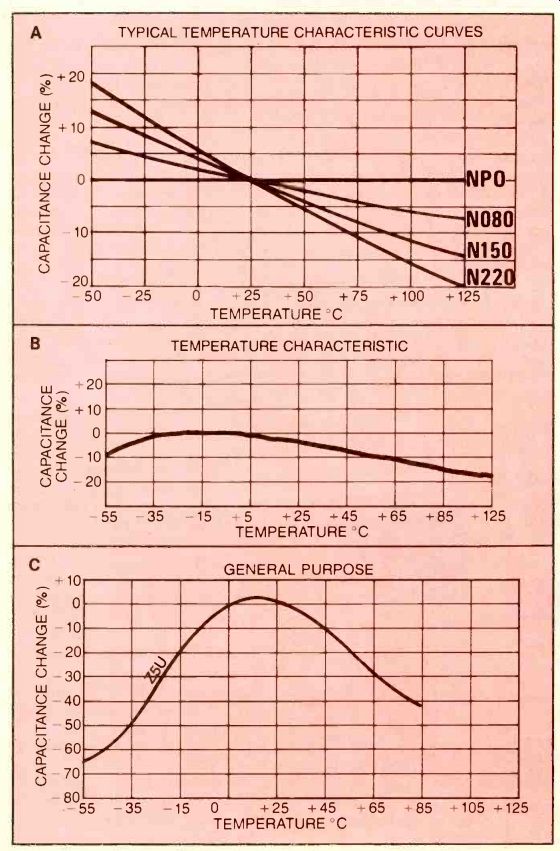
------ TYPICAL TEMPERATURE CHARACTERISTIC CURVES
Of course, some power from the voltage source and the capacitor charge is required to burn away the metal, otherwise the short remains.
A disadvantage is the limitation of maximum capacitor current. The metallized film is thinner than metal foil, so it cannot conduct a large current without excessive heating. Perhaps that is why polystyrene usually is not metallized, since it cannot withstand heat. In summary, metallized-film types are not recommended for operation with strong current from fast-repetition pulses.
Metalizing the films does not appreciably change the basic characteristics. Therefore, metallized capacitor types are not described separately.
Ceramic capacitors
Characteristics of ceramic capacitors cover a wide range, including the best and the worst specifications.
COG/NPO type BP has almost zero drift from temperature (about 3OPPM) and few aging effects. The N-series of temperature-compensating capacitors is similar except the capacitance decreases with rising temperature. The negative-positive-zero (NPO) ceramic capacitors are the only successful replacement for micas.

---------- Some computer-grade electrolytic capacitors have this internal
construction. Courtesy of Sangamo.
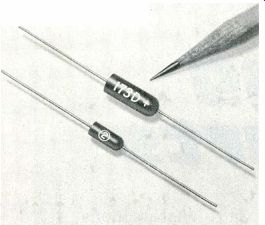
--------- When compared to aluminum-oxide filter capacitors, tantalum dielectric
types offer smaller physical sizes and longer shelf life with lower leakage.
Courtesy of Sprague.
X7R type BR ceramic capacitors are much smaller than NPO capacitors of the same value. They do exhibit appreciable aging and temperature effects, but are satisfactory for most bypassing and other non critical applications.
Z5U type GU ceramics are called high K because they have maxi mum capacitance in a minimum space. Unfortunately, they have severe temperature coefficient and aging effects, high dissipation, and capacitance variation from applied voltages. This type never should be used in oscillators or other critical circuits. In fact, Z5U type GU should not be stocked in service shops or used for replacements.
Avoid all ceramics that provide large capacitances in very small packages or those labeled high K.
Instead use X7R type BR ceramic capacitors for all replacements (of original ceramics) except those requiring NPO or negative-tempera ture characteristics. This simplifies stocking and avoids problems from inferior replacements.
Comments
It is false economy to stock capacitors according to price alone.
Plastic-film types having better specs than those of polyester cost slightly more, but the better stability can prevent many hours of call backs or additional troubleshooting.
Metallized-polycarbonate type can replace all wound-film types except for a few non-metallized poly propylene values needed for horizontal and pulse circuits.
Also see: Locating MRO parts
Capacitors: Components of many faces